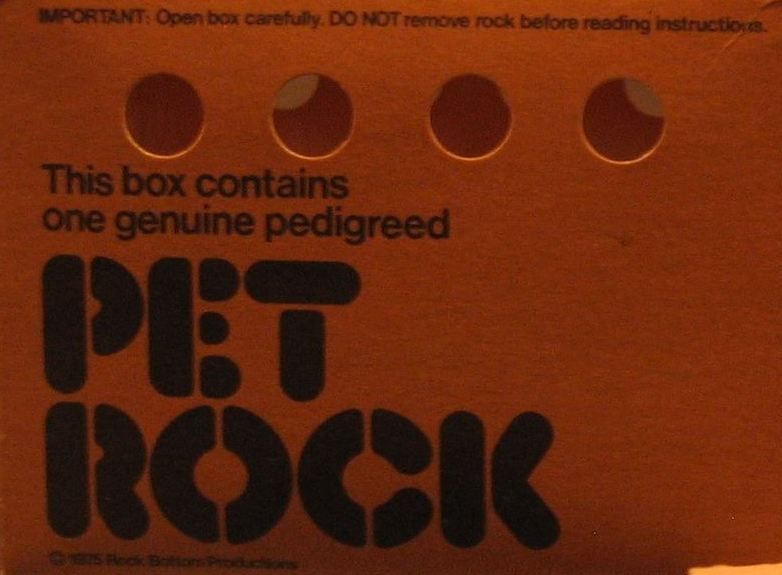You don’t want a live pet animal that requires feeding, grooming, playing, and taking out for a dump? Bothered by your dog’s non-stop barking all night long? Trying to get your cat off from scratching your furniture but failed miserably? You might as well own a Pet Rock!
If you grew up during the 1970s, you probably owned a Pet Rock.
You could have bought a bulk of it for less than a penny, or gathered a pound of it from the beach for free. But when Pet Rock first hit the shelves in 1975, they cost $3.95 each. The 1970s was a pretty great era for novelty gifts and items, fads and crazes. Pet Rock’s inventor, Gary Dahl, could have never launched it at a better time.
Taking advantage of a kind of novelty gift hysteria (and other factors), Dahl invented his gag toy, which became a national sensation and made him a millionaire. But he didn’t really get wealthy off of the rock – rather, it’s the way it was presented, from the cardboard packaging to the hilarious instruction manual.
It started with a few drinks…
Dahl was working as a freelance advertising copywriter in California at the time when this “so-stupid-it’s-so-brilliant” idea of a lifeless pet rock dawned on him.
Not surprisingly, Dahl’s concept of Pet Rock came about over a few drinks at a bar with friends one night. The alcohol-induced discussion turned to the destructive nature of pets. Dogs and cats destroy furniture. Worse, they require feeding, cleaning, grooming, walking, and lots of attention. Pets become sick and eventually die.
While his friends went on with their litany of complaints about their own pets, Dahl joked that he didn’t have to worry about any of those things because he owned a “pet rock.”
While his comment instantly garnered chuckles, Dahl later seriously considered that there could be more to it than that. He went home and began drafting an instruction manual for the “pet rock.” The manual, as expected, was full of gags and puns. There were instructions on how to best handle them, as well as the tricks it could perform (“play dead” being the most popular). There was also an instruction on how it could remain a faithful companion because of its “long-life span.”
Dahl proceeded to design a box for the hypothetical pet rock – cardboard with air holes that looked like the boxes used in pet shops. It also bore a passing resemblance to a McDonald’s “Happy Meal” box.
A serious motivation behind a funny idea
Although Dahl has been portrayed as a “freelance copywriter” in many write-ups about him, he later admitted that the job title was just a front. According to him, it was “another word for being broke.”
His motivation in making an effort to sell his hilarious “pet rock” idea was a serious one. He was experiencing dire financial difficulties at the time. His bills were mounting, and he was struggling to keep up with them. He recruited his colleagues George Coakley and John Heagerty as investors. They both signed on, with Coakley putting in $10,000. This was 1975, and the money wasn’t exactly a chicken feed, especially when the purpose was to sell virtually useless rocks.
Indeed, it was a considerable risk for Dahl and his investors – and taking risks is indeed part of the business. However, Dahl knew what he was exactly marketing. Like other crazes such as the Hula Hoop and the Yo-Yo, the Pet Rock benefited from the right timing. The Vietnam War had ended, but the Watergate scandal’s memories were still fresh in the minds of most Americans. The country’s mood was a bit “down in the dumps” at the moment, and Dahl believed that people would see the absurd nature of the Pet Rock and its humor.
Not a “hard” sell!
Dahl launched Pet Rock in San Francisco in August 1975. Americans understood the appeal and humor right away, and Dahl began taking large volumes of orders. Neiman Marcus ordered a thousand Pet Rocks. Bloomingdale’s followed. Newsweek ran a story of it, which further spread the word. Dahl then made an appearance on The Tonight Show. And as you would have guessed it, Pet Rock “went viral” in today’s terms. The year 1975 indeed was a big year for Dahl and his Pet Rock.
When the Christmas season arrived, Dahl estimated that he was selling about 100,000 Pet Rocks a day. Ultimately, he would sell from 1.3 million to 1.5 million Pet Rocks within only a few months. Coakley made a handsome $200,000 profit out of his $10,000 investment. Dahl also gave Coakley and Hagerty a Mercedes each as gifts. In short, the huge risk paid off.
As Pet Rock was designed to be a fad, it did not last. However, it became available again in recent years, with Rosebud Entertainment currently holding the US trademark rights to it. There is even an updated and “high-tech” version of it: the USB Pet Rock.
The Pet Rock was dumb. But it was so dumb, it was brilliant. The packaging and the way the rock was presented are pure genius. While Dahl didn’t really sell the rock itself, he sold the heck out of the absurdity of taking care of an inanimate object.


